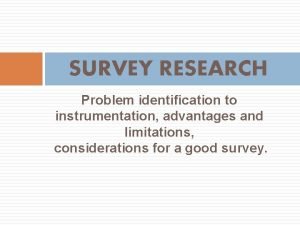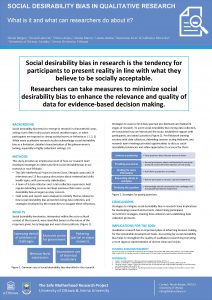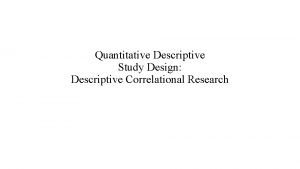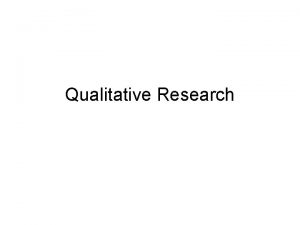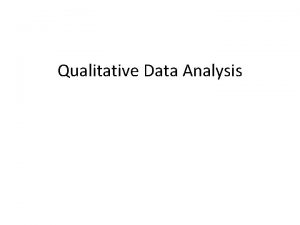Synthesizing Qualitative Research Ron Chenail Ph D TQR




























- Slides: 28

Synthesizing Qualitative Research Ron Chenail, Ph. D TQR Inaugural Conference January 8, 2010

Abstract Systematic reviews of research literature have emerged as important tools in evidence-based practice. The importance of qualitative research findings in this pursuit has led to the development of meta-synthesis approaches creating new interpretations from primary qualitative findings. A step-by-step process for conducting such a qualitative meta-synthesis will be shared.

Systematic Reviews �Systematic reviews of research literature have emerged as important tools in evidence-based practice. �Systematic reviews are: �Literature reviews that adhere closely to a set of scientific methods �Explicitly aim to limit systematic error (bias) � Attempt to identify, appraise and synthesize all relevant studies (of whatever design) in order to answer a particular question (or set of questions) (Pettigrew & Roberts, 2006)

Systematic Reviews �In these reviews investigators may focus their questions on �effectiveness of interventions and programs �impact of screening and diagnostic tests �exploring risk or protective factors �observational associations between interventions and outcomes �prevalence of clinical problems or conditions �subjective experiences about meanings, processes, interventions; methodological issues �economic factors (Pettigrew & Roberts, 2006)

Reasons to Include Primary Qualitative Research in Reviews �Abundance of primary qualitative research studies. �Qualitative research studies may focus on emerging areas of practice and research �Discovery-orientation of qualitative research may uncover patterns not previously studied in confirmatory-oriented research �Naturalistic designs employed in qualitative research studies may allow researchers to detect aspects of a phenomenon obscured by more controlled designs (Popay, 2006)

Reasons to Include Primary Qualitative Research in Reviews � Learning from the subjective experiences of patients and healthcare providers provides new insights into: � � � Quality of life issues Healthcare disparities, Cultural competencies (Popay, 2006) � Different research questions call for alternative methodologies and different methodologies can provide a greater variety of evidence (Popay, 2006)

Reasons to Include Primary Qualitative Research in Reviews �“Qualitative research is…viewed as essential to achieving the goal of evidence-based practice: namely to use the best evidence available as a foundation for practice without methodological prejudice” (Sandelowski & Barroso, 2007, p. 4) �Qualitative research findings are critical in “developing valid and culturally sensitive instruments and effective participant-centered interventions” (Sandelowski & Barroso, 2007, p. 5)

Types of Systematic Reviews �Narrative Review �Meta-Analysis �Meta-Method �Research Synthesis

Research Synthesis �A technique for synthesizing the results of primary research studies both quantitatively and qualitatively (Cooper, 1998, p. 4) �Integrating findings to reach a new theoretical or conceptual level of understanding and development � Integration More than the sum of parts � Inferences derived from findings as a whole � New higher-order interpretations created (Thorne, Jensen, Kearney, Noblit, & Sandelowski, 2004) �

Qualitative Synthesis Varieties �Meta-Ethnography (Noblit & Hare, 1988) �Grounded Formal Theory (Kearney, 1998) �Qualitative Meta-summary (Sandelowski & Barroso, 2007) �Qualitative Meta-synthesis (Sandelowski & Barroso, 2007) � An interpretation of qualitative findings that are themselves interpretive syntheses of data including phenomenologies, ethnographies, grounded theories, and other integrated and coherent descriptions or explanations of phenomena, events, or cases that are the hallmarks of qualitative research (Sandelowski & Barroso, 2007, p. 151)

Controversies �Publication bias �Is synthesis of different qualitative studies possible or advisable? �Context?

Systematic Review: Qualitative Meta-synthesis � � � � Formulate the review question Conduct a systematic literature search Screen and select appropriate research articles Extract the results Analyze and synthesize qualitative findings Maintain quality control Present findings (Sandelowski & Barroso, 2003, 2007)

Grounded Formal Theory of MFT Client Perceptions of Therapy Over the last twenty years a significant number of studies have been published in which the experiences of clients in marriage and family therapy (MFT) have been investigated to discover what works in therapy from their perspectives. Although there have been many systematic reviews of the effectiveness literature in MFT, there has not been a comparable review of the research literature presenting clients’ experiences of therapy.

Grounded Formal Theory of MFT Client Perceptions of Therapy To address this gap the investigators conducted a systematic review of research studies from 1995 to 2009 in which data were collected from clients regarding their experiences of MFT. The investigators used grounded formal theory to conduct their qualitative meta-synthesis to determine if there is a coherent model of client experiences of MFT.

Formulate the research question �Based upon information collected from clients regarding their qualitative perspectives of their experiences of marriage and family therapy and therapists, is there a coherent model of client experiences of marriage and family therapy?

Conduct a systematic literature review �Search databases including Google Scholar, EBSCOhost Family & Society Studies Worldwide, Pro. Quest Dissertations and Theses, Pro. Quest Psychology Journals, Psyc. ARTICLES, and Psyc. Info. �Used search terms including client experience, client perspective, marriage and family therapy, couple therapy, family counseling, qualitative research, grounded theory, phenomenology, and ethnography. �Identified 85 articles

Screen and select appropriate research articles �Utilize Inclusion / Exclusion Criteria Form to determine if each study (a) contains qualitative data from clients, and (b) focuses on conjoint family or couples/marital therapy. �Conduct an Individual Appraisal using the Critical Appraisal Skills Programme’s (CASP, 2006) Making Sense of Evidence Tool: 10 Questions to Help You Make Sense of Qualitative Research to determine (a) whether studies fully meet the project’s inclusion criteria; (b) if inclusion/exclusion criteria need modification; and (c) the quality of each study’s methodological rigor, credibility, and relevance. �Eliminated 30 articles.

Analyze and synthesize the qualitative findings �Read each article �Identify findings �Use in vivo and exported codes to code the findings

Analyze and synthesize the qualitative findings �Utilize “Rapid Grounded Theory” approach �Horizontal (e. g. , code to code) and Vertical Orientation (Findings to Codes to Categories to Themes to Theory) in first article �Horizontal and vertical constant comparison with each subsequent article �Theoretical Sampling to develop “left side of equation” �Harry, Sturges, and Klingner (2005) “Mapping the Process Approach”

Maintain quality control �Individual and group process �Audit trail �Member Checking / Peer Review �Grounded theory processes �Constant comparison �Theoretical sampling

Present findings �Display summary of the 55 articles �Harry, Sturges, and Klingner (2005) “Mapping the Process Approach” facilitates analysis to findings presentation progress

Addressing Limitations �Importance of screening articles �Transparency of method �Evidence of findings �Importance of theoretical sampling �Findings in context of evidence �Findings in relationship to participant and procedural variables �Contextual Generalizability �Triadic Perspective �Specific Saturation

Next Steps for You �Conduct preliminary search of published qualitative research studies in your general area of interest. �Reflect on purpose of review and intended audience �Conduct self-assessment for resources, time, and skill sets �Tools to assist reviewers http: //www. joannabriggs. edu. au/cqrmg/tools. html

Next Steps for You �Consider a consultant. � Cochrane Qualitative Research Methods Group http: //www. joannabriggs. edu. au/cqrmg/about. html �Recruit team. �Begin process of focusing review question and selecting systematic review methodology. �Begin the review!

References �Cooper, H. M. (1998). Synthesizing research: A guide for literature reviews: Vol. 2. Applied social research methods (3 rd ed. ). Thousand Oaks, CA: Sage. �Critical Appraisal Skills Programme. (CASP). (2006). 10 questions to help you make sense of qualitative research. Oxford, England: Milton Keynes Primary Care Trust. Retrieved January 7, 2010, from http: //www. phru. nhs. uk/Doc_Links/Qualitative%20 Appraisal% 20 Tool. pdf �Harry, B. , Sturges, K. M. , & Klingner, J. K. (2005). Mapping the process: An exemplar of process and challenge in grounded theory analysis. Educational Researcher, 34(2), 3– 13. �Kearney, M. H. (2001). New directions in grounded formal theory. In R. S. Schreiber & P. N. Stern (Eds. ), Using grounded theory in nursing (pp. 227 -246). New York: Springer.

References �Noblit, G. W. , & Hare, R. D. (1988). Meta-ethnography: Synthesizing qualitative studies: Vol. 11. Qualitative research methods. Newbury Park, CA: Sage. �Petticrew, M. , & Roberts, H. (2006). Systematic reviews in the social sciences: A practical guide. Malden, MA: Blackwell Publishing. �Popay, J. (Ed. ). (2006). Moving beyond effectiveness in evidence synthesis: Methodological issues in the synthesis of diverse sources of evidence. London, UK: National Institute for Health and Clinical Excellence. Retrieved June 5, 2007, from http: //www. nice. org. uk/page. aspx? o=530093

References �Sandelowski, M. , & Barroso, J. (2003). Toward a metasynthesis of qualitative findings on motherhood in HIV-positive women. Research in Nursing & Health, 26(2), 153 -170. �Sandelowski, M. , & Barroso, J. (2007). Handbook for synthesizing qualitative research. New York: Springer Publishing Company. �Thorne, S. , Jensen, L. , Kearney, M. H. , Noblit, G. , & Sandelowski, M. (2004). Qualitative metasynthesis: Reflections on methodological orientation and ideological agenda. Qualitative Health Research, 14, 1342 -1365.

Contact Ron Chenail, Ph. D. The Qualitative Report Nova Southeastern University 3301 College Avenue Fort Lauderdale, Florida 33317 USA ron@nova. edu
 Appendix research sample
Appendix research sample Instrumentation example in research
Instrumentation example in research Qualitative vs quantitative research
Qualitative vs quantitative research What is qualitative research
What is qualitative research Synthesis literary definition
Synthesis literary definition Process of synthesizing information
Process of synthesizing information Tuliskan ciri-ciri ringkasan abstrak dan sintesis
Tuliskan ciri-ciri ringkasan abstrak dan sintesis Synthesizing mind example
Synthesizing mind example Synthesizing sources examples
Synthesizing sources examples Difference between analyzing and synthesizing
Difference between analyzing and synthesizing Race writing method
Race writing method Synthesizing information allows a reader to
Synthesizing information allows a reader to Putting all the pieces together
Putting all the pieces together Synthesizing ideas in an informational text
Synthesizing ideas in an informational text Synthesizing images of humans in unseen poses
Synthesizing images of humans in unseen poses Flow map
Flow map Qualitative paper example
Qualitative paper example Holistic account in research
Holistic account in research Narrative report with contextual description
Narrative report with contextual description Methodological integrity in qualitative research
Methodological integrity in qualitative research Research instrument example
Research instrument example Social desirability bias in qualitative research
Social desirability bias in qualitative research Qualitative research traditions
Qualitative research traditions Sampling methods in qualitative and quantitative research
Sampling methods in qualitative and quantitative research Research sample definition
Research sample definition Results and discussion example qualitative research
Results and discussion example qualitative research Research question examples
Research question examples Expected output thesis sample
Expected output thesis sample Descriptive correlation research
Descriptive correlation research




















